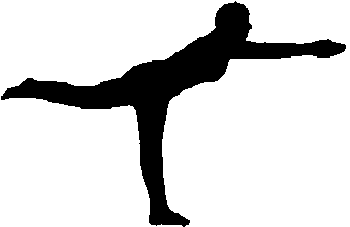Balance
 "Constantly
work on improving your balance, because the coordination you gain is crucial
to inline skating."
"Constantly
work on improving your balance, because the coordination you gain is crucial
to inline skating."
Good balance means coordination and agility when it really counts, and the ability to sustain the long glides of technically proficient stroking. That may seem obvious, but what many people don’t realize is that balance continues to improve over your lifetime based on what your body experiences. The more you stimulate the little balance mechanisms in your inner ears, the more your balance improves. Sport-specific work is great, but you can be improving your balance a little bit every day without much extra time or effort.
Lessons
Beginner
This entry-level balance work is fun and easy. During your leisure hours (you won’t be truly balanced if you don’t have at least some free time!) begin incorporating these one-foot balancing acts into your daily lifestyle.
Don’t forget to practice on both feet, or even spend more time on your “bad” foot. A full minute is a good goal to shoot for. If that's too easy, put a pillow between your foot and the floor.
 Either
barefoot or in supportive shoes, stand on one foot while you:
Either
barefoot or in supportive shoes, stand on one foot while you:
- Brush your teeth
- Open your mail
- Do the dishes
- Watch TV (or at least the commercials)
- Have a conversation
- Do Yoga’s Tree Pose: Press the sole of one foot firmly against the inside of the opposite ankle, knee or thigh, depending on your hip flexibility. Turn the bent knee out as far as possible. Once you’re steady, raise both hands overhead, palms facing inward.
Also consider buying a large exercise ball to sit on while working at your computer. This helps you build core strength and balance at the same time.
Return to topIntermediate
Use your own creativity to expand on the beginner balance moves above and increase the challenge with more difficult variations. While skating, see how far you can coast on one foot, extending the other skate ahead, to the side or behind you.
Use the following two balance poses to begin your current Yoga routine. (I also like to do these in front of the TV, between sets at the gym, or during a quick outdoors break at my day job.) These poses require concentration and strength as well as balance. Do them barefoot on a hard floor with your gaze fixed on a stationary mark. For more challenge, do them on a plush carpet or on a wobble board (see below). If you’re looking for less challenge, face a nearby wall and reach for it.
Start each pose as tall and erect as possible with weight equally balanced over both feet. (This is called Mountain Pose.) Try to hold the pose for 30 seconds or more on each side.
 Dancer’s
Pose (Natarajasana)
Dancer’s
Pose (Natarajasana)
- Raise your left arm overhead.
- Use your right hand to capture the right foot behind you.
- Tip your torso forward while raising the right knee up in back.
- Press your right foot into your right hand without twisting your body (keep shoulders and hips square to the floor).
- Try to get torso, right thigh, and outstretched left arm in a straight line, and if possible, parallel to the floor.
 Warrior
3 Pose (Virbhadrasana 3)
Warrior
3 Pose (Virbhadrasana 3)
- Raise both arms overhead, hands at shoulder width, palms facing in.
- Keeping your knee straight, extend your right leg back with your toe on the floor.
- Tip your torso forward while raising your back leg, maintaining a straight line from hands to right foot.
- Try to balance solidly on your left leg with hips and shoulders squared and parallel to the floor.
- The ultimate goal is a horizontal torso and right leg, forming a capital "T" shape.
Advanced
From the ORBIT archives, learn how balance works by reading Understanding Balance.
Surf the web for articles, aids and training tips to improve balance. For example:
- Balance Training, by Mary Concannon, M.A.
- Balance and Stabilization Aids at Perform Better.com
- Agility Training Products at JumpUSA.com
- Balance Problems Found Treatable by Training article at Fitter.first.com